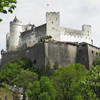HISTORY
Harlech
Castle is located in Harlech, Wales. It was built by Edward I, an English
monarch, and is one of his “iron ring” of Edwardian castles, with the
purpose of maintaining his rule over the Welsh. It was designed by the
famous medieval castle builder, Master James of Saint George, who himself
lived in it for a time.
It
is a traditional style castle with obvious emphasis on fortification and
strength but still provided elements of luxury to those who lived in it.
It is very impressive in architecture, engineering style, choice of
defenses, and was among the first wave of castles to be built with a sense
of art in mind. Construction took approximately seven years, from 1283 to
about 1290.
One
of Harlech’s most famous features is its idealistic medieval gatehouse,
which replaced the keep and became the residence of the castellan, the
governor of the castle. It is on the east wall of the castle and contains
four towers. Inside, it houses three portcullises, which are latticed
gates that could be pulled up and down. Thus, invaders of the castle
attempting to pass through the gatehouse could be trapped and then
attacked using arrow loops in the walls.
Harlech
Castle is basically rectangular and shaped into concentric defenses with
the strong gatehouse. It overlooks the town of Harlech on top of a hill
near a sea and has the additional defense of a moat.
It
was overtaken by the Welsh led by Owen Glyndwr in 1403, but then
recaptured by the English in 1409. It was later in a long siege during the
Wars of the Roses, which inspired the song “Men of
Harlech.”
BIBLIOGRAPHY
Johnson,
Matthew. Behind the Castle Gate: From Medieval to Renaissance. NY:
Routledge, 2002.
Kaufmann,
J.E., H.W. Kaufman. The Medieval Fortress: Castles, Forts, and
Walled Cities of the Middle Ages. MA: Da Capo Press,
2004.
Harlech
website.
<http://www.harlech.com/index.html>
LINKS
·
http://www.castlewales.com/harlech.html
·
http://www.shawnbrown.com/map_gallery/castle1
(Castle Map)
·
http://www.castlewales.com/menhar.html
(“Men of Harlech” lyrics)
Author:
Michael Carandang

